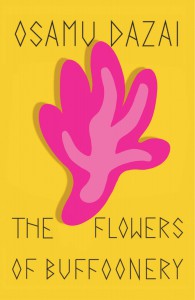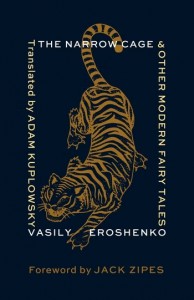In this month’s round up of the latest releases, we’re thrilled to introduce three singular works from rulebreakers, free thinkers, and true originals. From Japan, an early novella from the nation’s renowned enfant terrible, Osamu Dazai, gives a telling look at the writer’s internal monologue. From the Nobel laureate Issac Bashevis Singer, a bilingual edition of the Yiddish author’s story—in multiple translations—opens up an inquest into the translator’s pivotal role. And from the Ukrainian émigré Vasili Eroshenko, a collection of the author’s fairy tales, translated from the Japanese and Esperanto, presents a well-rounded selection of the transnational author’s politically charged work. Read on to find out more!

Simple Gimpl by Isaac Bashevis Singer, a definitive bilingual edition with translations from the Yiddish by Isaac Bashevis Singer, Saul Bellow, and David Stromberg, and Illustrations by Liana Finck, Restless Books, 2023
Review by Rachel Landau, Assistant Editor (Poetry)
Whether you choose to know him as “Simple Gimpl” or “Gimpel the Fool,” the main character of Isaac Bashevis Singer’s novella is a likable, rambling man who finds himself in an unfortunate situation. His wife, Elka, is frequently using their shared home for affairs with other men, and all of Gimpl’s attempts to come to terms with the situation are complicated by his deep love for her. Even when the pair are forbidden by the town rabbi from seeing each other, Gimpl works tirelessly to provide for the children and for Elka. He feels betrayed to learn, at the end of Elka’s life, that the children were not really his—and his reaction to this deception is a surprising one.
The narrative in Simple Gimpl is slow-moving, reflective, and witty. It is an undeniable pleasure to read—and certainly not difficult to read multiple times in a row, as this edition of the book incites the reader to do. This “definitive bilingual edition,” released by Restless Books, includes back-to-back translations of the Yiddish work; first is Isaac Bashevis Singer’s “Simple Gimpl,” which is followed immediately by Saul Bellow’s “Gimpel the Fool,” and this compendium of translations is decidedly about translation itself. Over the course of more than one hundred pages, one must realize that this is not a book about Gimpl, and not even about the differences between Saul Bellow’s Gimpel and Isaac Bashevis Singer’s Gimpl. It is about the role of the translator; it is about the strange impossibility of rendering a story.
To offer an example: at the start of the fourth chapter, in the translation by Singer and Stromberg, the Evil Spirit comes to Gimpl, awakening him. He asks: “Gimpl, why are you sleeping?,” to which Gimpl responds, “What should I be doing, [. . .] eating dumplings?” Bellow treats the scene ever-so-slightly differently. The Evil Spirit asks, “Gimpel, why do you sleep?,” to which Gimpel responds, “What should I be doing? Eating kreplach?”
“Kreplach” invokes the tasty, triangle-shaped boiled dumplings regionally and temporally specific to the world Bellow wants to construct in his translation; dumpling, on the other hand, is a generic term that does not confine Gimpl’s use of language to the author’s region. One choice characterizes Gimpl as a product of his land, and the other allows for a literal interpretation of the language used.
So often, translators must choose between one iteration or another for the final draft. Both in this moment and across the whole book, Simple Gimpl accentuates the fact that the greatness of this translation lies not in the choice of words, but in the decision not to choose: we get our dumplings and our kreplach, and as a result, the story—and us alongside it—grows immensely from each contemplation.
Indeed, the most exciting thing about this collected translation is its accessible approach to explaining the at-times perilous world of language in which the translator lives. How deep are the consequences of translating what Isaac Bashevis Singer calls Gimpl’s tendency to be “easily deceived,” as Bellow’s suggestion that Gimpl is “easy to take in”? Learning and unlearning Gimpl’s characterization while enjoying the stylistic preferences of two very different writers is a great pleasure of this text. Also, as the kreplach scene suggests, the book also pushes the reader to contemplate the cultural differences between the Americanized translators of the story—Bellow, Greenberg, and Howe—and the author’s own lived experience on two continents. Stromberg accuses Howe and Bellow, in particular, of projecting ideas of “old-world” Yiddish culture onto Singer. Whether or not the consequences of this projection are a flattening of the translation and a less-sophisticated rendering of Gimpl is left up to the reader to decide.
As such, whether or not the reader is not a trained translator or literary scholar, they will end up double-checking every sentence, cross-checking words and phrases, without any training or impetus to do so. In my own reading, I was heavily influenced by David Stromberg’s essay, an illuminating piece that pushed me to reflect more and more on what I had read. On one hand, without Stromberg’s guidance, the intention of the parallel translations runs the risk of being fully lost. On the other, a lack of context cannot destroy the automatically-pleasant experience of reading such rich literary language.
As if this delightful literary experience was not enough, the pages are graced with lovely illustrations by Liana Finck, whose playful and emotive style adds incredible texture to the book. The lines, colors, borders, and visuals cumulate in a phenomenal reminder that our visualization of any story, across any number of languages, remains our own subjective experience of that text. There is no better reminder to get from a book so dedicated to—or even obsessed with—its presentation of language.

The Flowers of Buffoonery by Osamu Dazai, translated from the Japanese by Sam Bett, New Directions Press, 2023
Review by Andrea Blatz, Blog Copyeditor
Like many, I am constantly doubting myself and my qualifications. One second, I think I’m a shoo-in for a position; the next, I am disastrously underqualified and I’ll never find be able to start a career—imposter syndrome strikes again. Osamu Dazai (1909–1948), the pen name of Shūji Tsushima, wrote the second-best selling novel in Japan in 1948, but in one of his early novellas, The Flowers of Buffoonery (1935), we see the author’s uncertainty regarding his skills as a writer—a feeling that the author breaks the fourth wall to frequently explicate. The narrator, arguably a stand-in for Dazai, uses these asides to look critically at his life and his decisions, but the fictionalized format maintains the separation between the author and the narrator, dividing what Dazai says and what his narrator says, allowing a more honest reflection. Sam Bett, whose translations are seemingly omnipresent these days, renders Dazai’s prose in a way that underlines the author’s dark humor, without ignoring the complexities of depression.
The story, which Dazai later expands on in his most well-known text, No Longer Human (1948), follows the protagonist, Yozo Oba, a young man from a wealthy family. He has quit school and turned to drinking, leading his family to disown him. The Flowers of Buffoonery opens with Yozo recovering in a sanatorium; he and his lover, Sono, had jumped off a cliff in a suicide attempt, and he is the sole survivor. The narrator tells Yozo’s story as he recovers, surrounded by a rotating cast of his friends, his brother trying to help him evade punishment, a nurse who takes care of him, and police who question him about Sono’s death. Throughout the story, Dazai speaks directly to the reader, chiming in with his own opinions about what has happened to Yozo, and specifically, his distaste for how the story is playing out.
Like Yozo, Dazai was born to a wealthy family, starts university but soon drops out, and attempts suicide with a woman, who does, unfortunately, die. Also like Yozo, Dazai does not face any charges in the woman’s death. A result of being born into money, Dazai/Yozo enjoyed a childhood in which they were spoiled by the adults around them, never having to face the consequences of their actions. In this novella, it seems as though Yozo is unaware of the ramifications of his cliff jump, only thinking of how he can be saved: “In my satanic insolence, I prayed for my salvation in the same breath that I prayed Sono would die.”
Despite the dark subject matter, the tone throughout The Flowers of Buffoonery is surprisingly light. Much of the text revolves around Yozo, his friend, and his cousin—both staying with him in the sanatorium, making passes at the female patients and trying to cheer up the convalescent with card games. The title, however, undermines this lightness. Dazai studied French literature in school, and the title is a play on Baudelaire’s Les Fleurs du mal (The Flowers of Evil). By replacing “evil” with “buffoonery,” Dazai shows an awareness of his characters’ immaturity, even if he fails to do anything to alter the course. Instead, he addresses the reader with an explanation:
Surely by now, dear reader, you’re disgusted with these young men for the carefree way in which they pass the time, as if one among them had not just killed another human being, though I suspect this new development will elicit shouts of joy. Serves him right, etc. How cruel of you. What part of what you see here is carefree? If only you could understand the sadness of the ones who grow the delicate flowers of buffoonery, protecting them from but the slightest gust of wind and always on the verge of despair!
Here, as in much of the text, we see Dazai going back-and-forth, in one breath telling the reader to be “disgusted” with how the young men fail to acknowledge the death of Sono, then turning around and chastising the reader for being quick to judge. Dazai tells Yozo’s story one way, then reverses course in his asides, showing us the tensions and distances that can grow between one and oneself.
In the end, the nurse and Yozo take a hike to see Mount Fuji, which remains stubbornly behind the clouds. Instead of telling the reader what happens to his narrator, Dazai leaves the reader with an unsatisfying view: “And then—no, that’s all I have.” Seemingly giving up on the potentialities that he as a writer can endlessly explore, Dazai, for now, leaves the reader to make up their own ending.

The Narrow Cage and Other Modern Fairy Tales by Vasily Eroshenko, translated from the Japanese and Esperanto by Adam Kuplowsky, Columbia University Press, 2023
Review by Ian Ross Singleton, Nonfiction Editor
What makes the fairy tales of Vasily Eroshenko “modern”? After losing his sight as a child in Obukhovka, Ukraine, the writer attends a school for the blind in Moscow before going on to travel widely, settling down for extended periods in Japan and China. His stories, which helped the author make sense of these disparate worlds he travelled through from 1890 to 1952, update and subvert tradition, bringing well-worn elements into a contemporary understanding—which might or might not cohere with their original values. As the reader begins to trace the pattern of these narratives, it becomes clear that, like typical folk tales, they repeat a single action, amplifying it at each new occasion until something changes irrevocably. As in the typical fable, Euroshenko displaces the human world into the wider animal kingdom, using various depictions and relationships of the non-human to subtly hint at human truths.
While the author held to his Ukrainian roots (he wore a traditional vyshyvanka and played Ukrainian folk songs on a balalaika) and wrote fairy tales similar to many of those associated with Ukrainian folk culture, he has been referred to as a “Tolstoyan” and a “transnational common man,” extending his craft to languages that he studied throughout his life. Eroshenko’s socialist views and international perspective further complicate the fairy-tale, morally simplistic view of the world. A radical polemicist and internationalist who was expelled for Japan for his avid socialist movements, the political messages Erosheko imbued into his writings include the exposure of blatant class distinctions. Many of the stories in The Narrow Cage present this stance, such as in “The Martyr,” in which socio-economic divisions are transposed onto a conversation between different species:
“Oh, dear,” said the Mosquito in a timid voice. “I hope that I haven’t offended you. But were you really not born in the pond?”
“Certainly not!” snapped the Honey-bee. “To be sure, you may have been born in that stink-hole, but I was born in an apiary, like a respectable creature, and was raised by a governess.” And she raised her pointed stinger in the air.
“That is not a thing to be proud of,” snickered the Bush Warbler from his place in the tree. “After all, who isn’t raised by a governess these days? Really, you are a person of little importance, whereas I belong to the higher orders, for I was born on a country estate in Java. Of course, it is summer-time there, so I am only here on a sojourn. As to my education, I can assure you that my parents spared absolutely no expense in hiring the finest poets to serve as my teachers. So there is really no comparing us at all.”
“Hmph!” snorted the Cow. “What trivial persons you are! Tell me, can either of you say that you were born in an actual house? Well, I can. And what is more, I am told that there were three human beings in attendance for the occasion.”
The little Mosquito was quite taken aback. “But regardless of where we are born,” he remarked, “surely we can agree that our hearts are one and the same.”
“Dear no!” cried the Honey-bee. “For if we are born in different places, then it stands to reason that we ought to have different hearts.”
Laced with humor, these political messages are as prominent as they are entertaining, served with a levity that tempers their passion. Another story that belies the author’s socialist background is “The Death of a Canary,” wherein a cat is described as a capitalist, “laying claim to whatever he sees” with his sharp claws and teeth. The titular canary, an innocent seeker of socialist ideas, is murdered by the cat, who attempts to justify his greed by stating: “If it weren’t for us capitalists, you artists would never survive,” before extending his claws and effectively skinning the canary. In this, the symbol of capitalism dominating peoples’ lives becomes horrifically literal.
Religion, too, is an institution that does not escape Eroshenko’s scrupulous examen. “The Sad Little Fish,” for example, is a tale about a very “Christian” carp who martyrs itself for a man. At the end, the narrator declares that beings of the natural world should not martyr themselves for human beings, rebutting Christian concepts of self-sacrifice. But while he resists religious ideals, Eroshenko also seems to occasionally adhere to tenets that diagnose the nature of humanity as having “fallen”; in “An Eagle’s Heart,” the noble eagle characters sing a warning to other eagles not to go down to the valley below, a corrupt place. Thus, while Eroshenko ridicules Christian ideas, he nonetheless writes of rejecting the human world—and the only character he depicts as truly virtuous is a monk.
Fairy-tale scholars have attributed these ideas to Eroshenko’s efforts to craft a “quest narrative” about disability. However, in making his fairy tales “modern,” the author subverts even this idea of a redemptive narrative for people with disabilities. The story from which the collection takes its name makes sense in this respect; it depicts a tiger who rejects the world but also prays to a god—in whom the tiger doesn’t believe—to be freed from its cage. Equally ironic and cryptic, the tiger is perhaps a stand-in for Eroshenko’s worldview, complete with all of its illusions, delusion, and dreams.
To add to the underlying complexity of these moral stories is the languages they are written in—Japanese and Esperanto. According to translator Adam Kuplowsky’s introduction, Esperanto was created in the late nineteenth century as a grammatically simple language, in an attempt to “promote nonhierarchical communication” between nations. While Eroshenko chose Esperanto as his “beloved tongue,” Japanese was more of a functional language for him after he immigrated to Japan (a country renowned for excellent treatment of the blind). However, Kuplowsky documents and writes about how Eroshenko’s Japanese was “imperfect.” A specific complication appears to have come from the author’s reliance on transcriptionists, so the quality of some of the Japanese-language tales suffered, while others are “quite polished.” Relying on translations into Chinese as well as translations by Japanese Esperantists, Kuplowsky remarks about this volume: “Perhaps more than any other translator of Eroshenko’s work, I have been quite liberal with my edits.”
So this collection is not only a vital collation of Eroshenko’s moral and political work, but also a representation of the translator’s labor, and what enhancements can result from this dedicated work. Kuplowsky’s daring edits reflects Eroshenko’s daring itself, writing in a language of which he had an “imperfect” knowledge. Perhaps what some would consider a “perfect” application of language is the lyrical play some native speakers are able to enact, but Eroshenko’s pursuit of literature despite this imperfect voice emblematizes a deep desire to speak, instead, perfect truths. Kuplowsky acknowledges this effort, naming the reasoning behind his liberal edits as “endeavoring to convey Eroshenko’s lyrical voice and impassioned political messages.”
As in “A Spring Night’s Dream,” Eroshenko writes: “Oh, but I am afraid that there are neither words nor images capable of expressing the sadness felt by these poor creatures!” The statement suggests not only the deep flaws of the world, but the imperfect efforts of the author and any human creator. While the tales don’t necessarily demonstrate the eloquency of a writer in their native tongue, the style remains true to the pace of traditional storytelling, coming through in well-plotted, brief scenes. The effect serves a different, perhaps greater, purpose: to teach us through their small yet impassioned messages about how the world is, and how we should live within it.
*****
Read more on the Asymptote blog:

